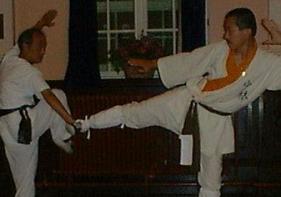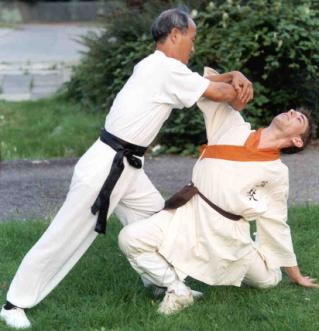|
|
|
Lost trail Boxing
Mizong Quan
Mizong is a style of Chinese martial art style, originated from the Shaolin Temple, to many Chinese, it requires little introduction, as it has produced disproportional high number of famous masters in the recent past, such as Master Hou Yuan Jia and Lu Zheng Dou and made into films, the Most famous one is perhaps Hou Yuan Jia, which was protrated in Jet Lee's film of the same name and depicted as Bruce Lee's Master in the film Fist of Fury.
Shaolin Mizong is articulate, fast,
elegant and effective. Techniques encompass traditional elements of Ti (Kicking
and leg); Da (Punching and hand technique), students are also drilleded in Swai
(Throwing and holding); Na (Grabbing and manipulating of joints).
Mizong style martial art is quite distinctive compared to others Northern Shaolin style martial arts, containing soft (internal) and fast & hard (external) technique. Soft techniques are used to trained the prowess (gong), fast techniques for attacks, the movements are shorter compared with other Northern style, but very good with hands, and as with other Northern Shaolin renounce for its leg techniques. Hall marks, are that hand and leg techniques co-ordination, always looking to attack even when defending, deceptive and real, soft and hard techniques compliment each others, very unpredictable. Attacks always in sequence. Lines of attack and defence are often diagonal, shifting constantly, each movement can be developed into defensive or attacking fluently, in experts’s hands is very unpredictable hence alias Lost Track boxing. It is also called Yen Chin Fist (Yanqing quan).
History
Mizong martial art, is a major style of Northern Shaolin martial art originated form the Shaolin Temple, founded in the Tang Dynasty (600 a.c)by the Shaolin Monk “Chin-Na-Law”, it is said that Monk “Chin-Na-Law” , a already an accomplished martial art master, was travelling outside the temple to visit other masters, this day he saw group of gibbons fighting and chasing one another, the agility and the ability to move with extreme ease even in such frantic circumstances inspired him so much that he later analysed and incorporated the concept into his fighting skills and formed Mizong Style. Monk “Chin-Na-Law”'s tomb still can be founded at the Shaolin Temple today.


This style of martial art is widespread in
North-East China, it is also named “Yen-Chin Fist” or “Green Swift Fist” after
a famous Sung Military
General Yen Chin who were an expert of Mizong. There are a number of alias e.g
Maze Boxing or Lost Track. In the martial art world, most have heard of Mizong
(with different aliases) but very few have seen it, mainly due to the migration
demography outside China.
There are a number of alias e.g Maze Boxing or Lost Track. In the martial art
world, most have heard of Mizong (with different aliases) but very few have seen
it, mainly due to the migration demography outside China.
Mizong being a major style with long history of development, is rich and very comprehensive, it is stylist, as it is a soft and hard style, practisetioners do not therefore have to rely on strenght alone, is suitable for all age groups and wide range of physical conditions.
Syllabus consist of Tan Tui foundation,
bare hand forms (one man), bare hands (paired form), san sau (free fight), one
man and paired weapons froms (daggers, short stick, long pole, spear, sabres,
3-section staff, Sun & Moon wheels etc)
According to the legend this style comes form Yan Qing, a hero the novel "Water margin tales".
But it seems that another legend states that the true founder of this style is Sun Tong (early 1800's) from Shandong province who studied wushu at Songshan Shaolin Temple and created Mizong quan when he settled down at Canxian in Hebei province. There is at least 8 mizong quan substyle.
This style was taught in the Jingwu Tiyu Hui and later a new variant was created Mizong Luohan quan, associating those 2 styles.
Main features: Tricky footplay, illusions like in Zui quan, short circular motion like in Bagua zhang.